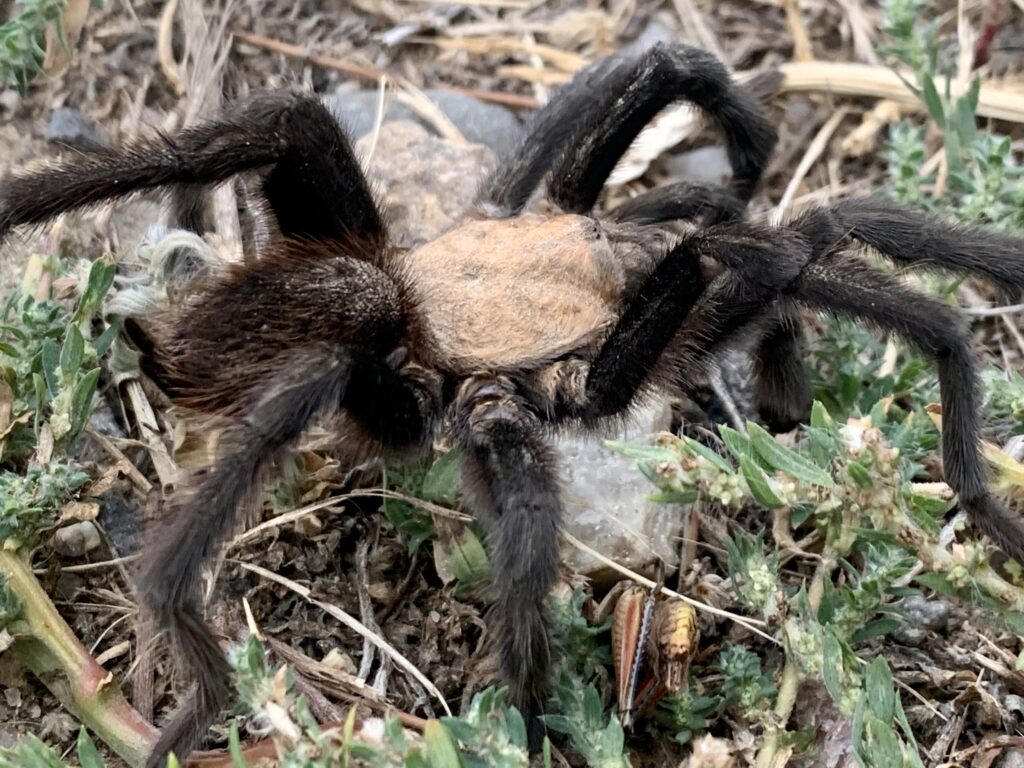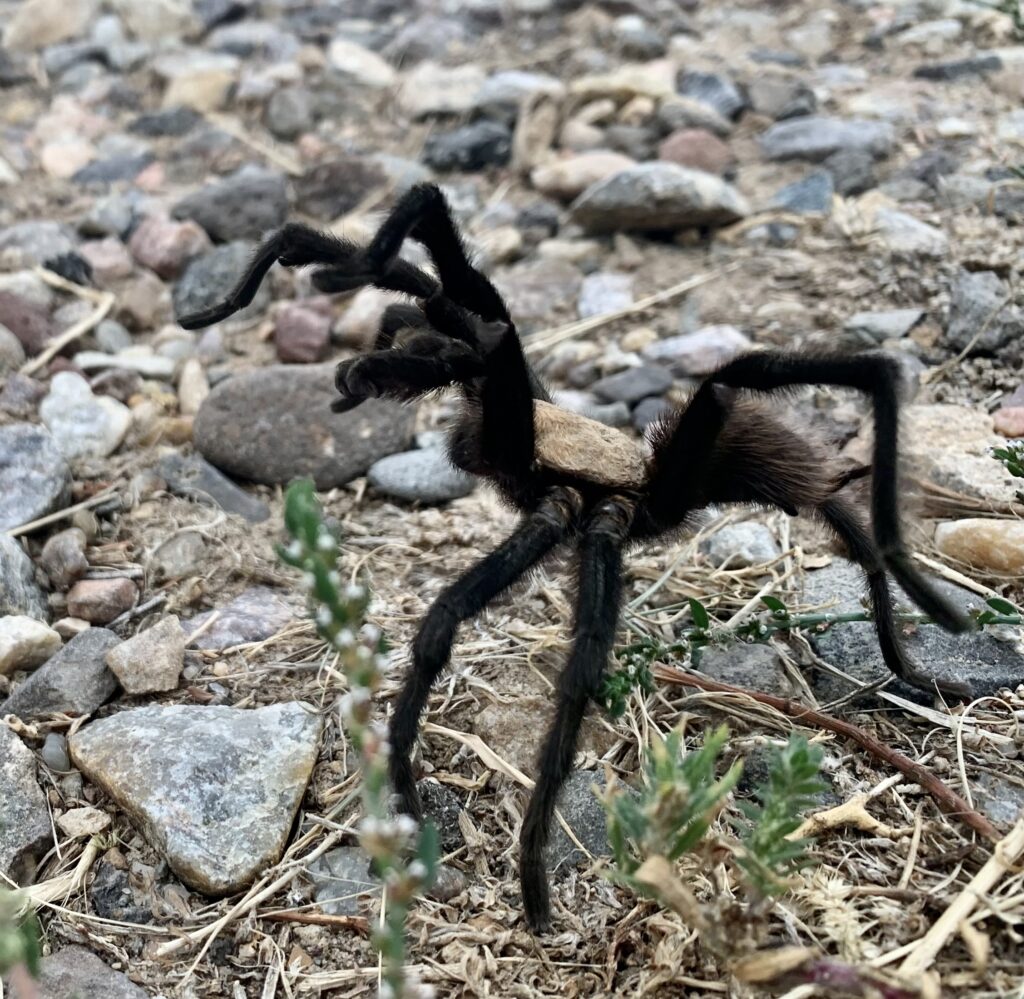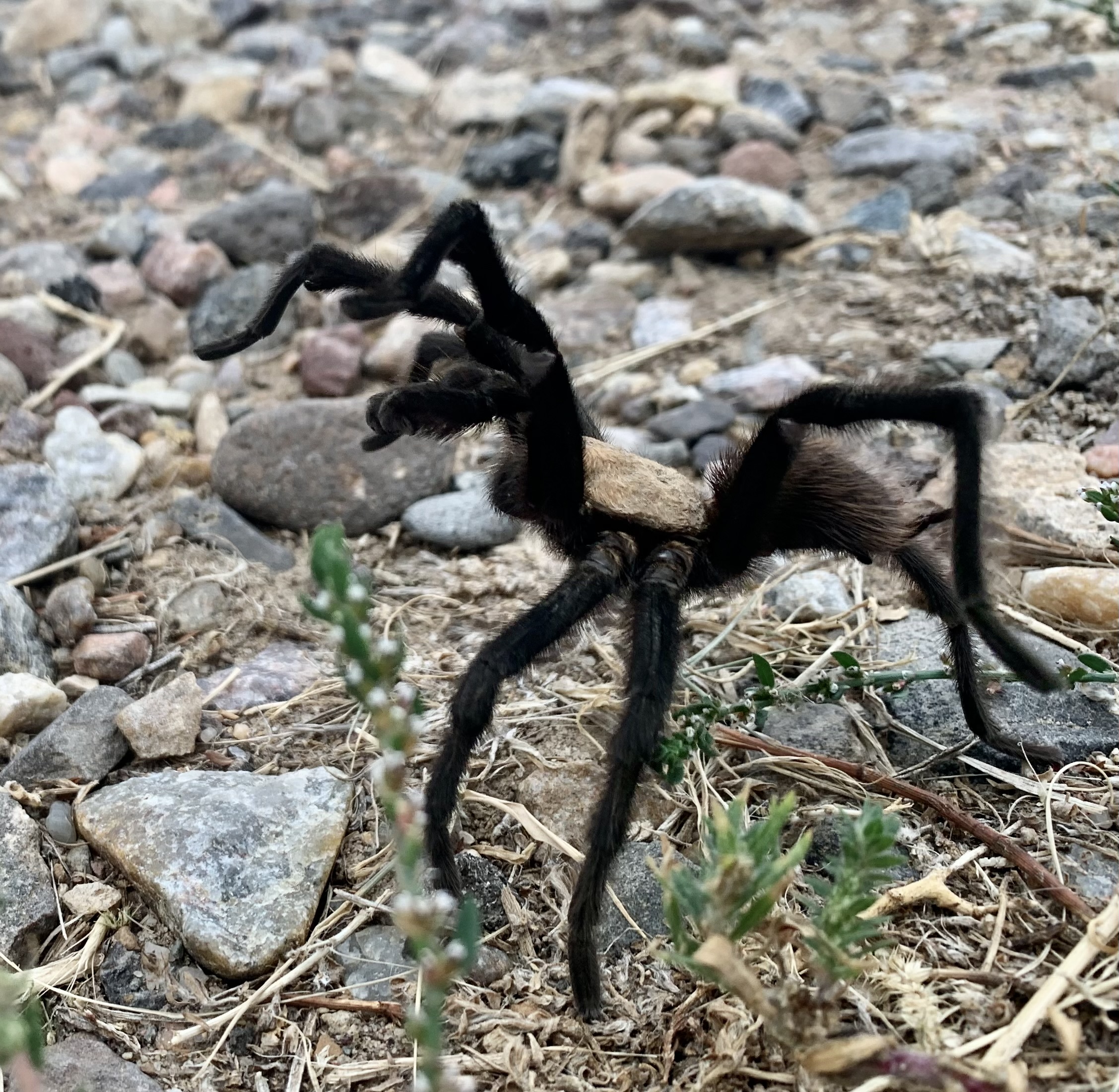In southeast Colorado and the surrounding high plains states a ritual as old as time, and often misunderstood as a “migration”, begins stirring. It happens in the early fall of every year, usually September and October. Male tarantulas at the end of their life gang up in groups and set out on a slow and dangerous adventure to find a mate. (visit La Junta) The spiders can track long distances during this time, and as a consequence, this is the time when most people see a tarantula since they are often out during the day at this time of their lives. The otherwise nocturnal hunters are seldom seen.
These Oklahoma Brown tarantulas are also known as the Texas Brown and Missouri Tarantulas. They are less widely but more accurately known by their scientific name as Aphonopelma hentzi. The Oklahoma Brown tarantula are the species that are found trekking in southeast Colorado, Kansas, Oklahoma, Texas, Missouri and much of northern Mexico during the fall months.
The Trek to Find a Mate
The female tarantulas build burrows most usually in undisturbed prairie rangeland and stick close that home for the rest of their lives which can be 25-30 years long! Male tarantulas are much shorter lived. Often not living past their first year. But when they do, they seldom live past their trek to find a mate which is when they are approximately 8 years old.
When a male tarantula finds a female (he does this by scent) he approaches the entrance to her burrow and taps on thin strands of web that lead into the burrow. If willing the female will exit the burrow and mating will occur. If the female is hungry she may make her anxious suitor her next meal. (NPS) This is a way for the female to recycle protein.

In addition to their eight legs, Tarantulas have pedipalps. These are mainly sensory appendages. Although they resemble shorter front legs, pedipalps are just designed to help tarantulas to feel their environment. More like arm, the pedipalps usually have only one claw each, compared to their true legs that each contain two claws. In males, the pedipalps are also used for sperm transfer. (NPS)
When female tarantulas reproduce, they line the walls of their burrow with eggs and stay close by until the young tarantulas emerge. Often, the young stay with the mother for about a week before dispersing.
Defense & Feeding
A tarantula’s burrow functions not only as places to lie in wait for potential meals, but also as refuges from lizards, birds, skunks, and other enemies. The tarantula is not a typical web spinner; they do not weave aerial webs to trap prey. Instead, they burrow into the ground to make a home for themselves, and they line their home with webbing to prey on grasshoppers, crickets and other similar insects. They line the entrances of their burrow with silk to serve as an alarm system for potential predators and potential prey. (wildlife department)

The males use the hairs on their body and legs to accentuate their sense of touch and vibration useful in finding prey, detecting predators, and even defending themselves. When a tarantula feels threatened they use their hind legs to scrape barbed hairs, called, urticating or stinging hairs, from their abdomen and flinging them in the direction of the threat. The hairs can cause a very irritating rash when they make contact. Tarantulas can defend themselves from coyotes, fox, snakes and even some birds.(wildlife department) People may even suffer a serious allergic reaction as a result, especially if the hairs come in contact with their eyes. (thought co)
The venom of tarantulas has no medical significance for humans, being something like a bee sting. (education-field guide) Tarantulas use their venom to paralyze and incapacitate their prey. The venom also aids in the process of eating the prey as they have no teeth with which to “chew.” The venom, which would be similar to a bee sting if a human were to get bitten, slowly liquifies their meal so they can suck it up. Tarantulas feast on insects, small lizards, frogs, and some small snakes.
Tarantulas as Pets
These tarantulas are not typically aggressive to humans, and are good natured spiders that require very little space when kept as pets. The Oklahoma Brown Tarantula is one of the calmest and most handleable tarantulas as they are quiet, easy to care for, and are an ideal species for a beginner. (animal world) However, they can be easily hurt or damaged if handled wrong or dropped, so unless you know what you’re up to. Just admire them as they do their thing.
Viewing Tips
- September and early October are the best months to try to see a tarantula in the day light.
- Venture out on a day that is warm, and preferably not too windy.
- Some tarantulas will be active in late afternoon.
- Things really pick up in the hour before sunset.
- Around 5:45 p.m. -6:00 p.m. or so, and peak lasts about an hour.
- Ideal viewing south of La Junta on Highway 109, on the Comanche National Grassland at Vogel, Picketwire, Picture Canyon and Carrizo Canyon. Plus all the roads in between!
- Take a hike! Hiking any of the trails on the Comanche National Grassland can be an excellent way to view and find tarantulas trekking.
- When viewing tarantulas on highways be aware of impeding traffic, and traffic safety.
Some viewing tips taken from (https://visitlajunta.net/about/tarantula-migration/)
Resources
https://visitlajunta.net/about/tarantula-migration/
https://www.wildlifedepartment.com/wildlife/field-guide/invertebrates/brown-tarantula
https://animal-world.com/encyclo/reptiles/spiders/OklahomaBrownTarantula.php
https://education.mdc.mo.gov/discover-nature/field-guide/texas-brown-tarantula
https://www.thoughtco.com/tarantula-anatomy-diagram-1968567
https://keepingbugs.com/how-do-tarantulas-catch-their-prey/
https://www.nps.gov/band/learn/nature/upload/tarantula%20fact%20sheet.pd

